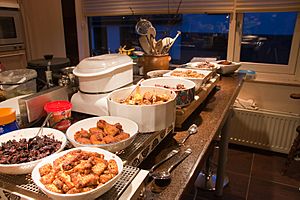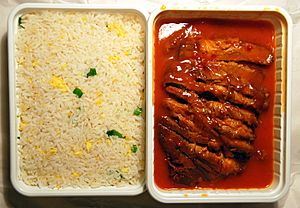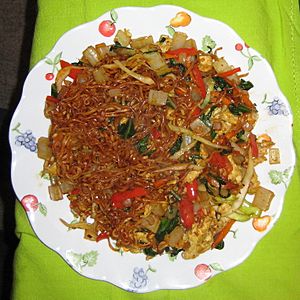Indo cuisine facts for kids
Indo cuisine is a special mix of cooking styles. It blends traditional Indonesian cuisine with flavors from Europe, especially Dutch food. You can also find touches of Portuguese, Spanish, and British cooking.
This unique food tradition is mostly found in Indonesia and the Netherlands. You can also enjoy it in Belgium, South Africa, and Suriname. Today, not only Indo people eat Indo cuisine, but also many Indonesians and Dutch people love it.
Contents
History of Indo Cuisine
How It Started
During the time when the Dutch ruled Indonesia, Dutch families living there learned about Indonesian food. Their cooks and servants introduced them to amazing tropical spices and dishes. This is how they started to love the local flavors.
A very famous dish from this time is called rijsttafel. This "rice table" is a huge feast! It can have anywhere from 7 to 40 popular dishes from all over Indonesia. The Dutch rulers used this grand meal to enjoy many different foods at once. It also helped them impress visitors with the rich variety of their colony.
European Flavors in Indonesia
The Dutch also brought their own European foods to Indonesia. Things like bread, cheese, barbecued steak, and pancakes became popular. Since Indonesia grew crops like coffee and tea, these drinks were also very common.
Dutch colonists and Indos often ate bread, butter, and margarine. They also enjoyed sandwiches with ham, cheese, or fruit jam. Small pancakes called poffertjes and larger ones called pannekoek were also favorites.
Some Indonesian nobles and educated people also learned about European cooking. They saw it as fancy food for the upper class. This led to a wonderful mix of European and Indonesian cooking styles.
Dishes Born from Fusion
Many dishes we enjoy today were created during this colonial time. They show a clear Dutch influence. For example:
- selat solo (Solo salad)
- bistik jawa (Javanese beef steak)
- semur (a stew from the Dutch word smoor)
- sayur kacang merah (red bean soup)
- sop buntut (oxtail soup)
Even many cakes and cookies have Dutch roots. These include kue bolu (tart), pandan cake, lapis legit (spekkoek), spiku (lapis Surabaya), klappertaart (coconut tart), and kaasstengels (cheese cookies). The small pancakes called Kue cubit, often sold near schools, are thought to come from poffertjes.
Indo Cuisine in the Netherlands
Indo cuisine has had a huge impact on the Netherlands. You won't find as much Indonesian food anywhere else outside of Indonesia itself! Indo people were key in bringing both Indonesian and Indo fusion food to the Netherlands. It became so popular that many people now see it as a part of Dutch cuisine.
Countess C. van Limburg Stirum wrote in her 1962 book, "The Art of Dutch Cooking": "There are countless Indonesian dishes, some taking hours to prepare; but a few easy ones have become so popular that they can be regarded as 'national dishes'."
She shared recipes for dishes that are now common in the Netherlands:
- nasi goreng (fried rice)
- pisang goreng (fried bananas)
- lumpia goreng (fried spring rolls)
- bami (fried noodles)
- satay (grilled meat on skewers)
- satay sauce (peanut sauce)
- sambal ulek (chilli paste)
Most towns in the Netherlands have an Indies or Indonesian restaurant. They also have tokos, which are shops selling Indonesian ingredients and ready-made food. Even many Chinese restaurants have added Indonesian dishes like babi panggang (roasted pork) to their menus. Many now call themselves "Chinese Indies Restaurants."
Popular Indo Dishes
Here are some popular dishes you might find in Indo cuisine:
- Acar: Pickled vegetables or fruits, often made with cucumber, carrots, and chili. They are pickled in vinegar.
- Ayam kodok: A whole chicken that is stuffed and roasted. It's often served for special holidays like Christmas.
- Babi kecap: Pork belly cooked slowly in a sweet soy sauce.
- Babi panggang: Grilled or roasted pork served with a special tomato sauce.
- Bakpau: An Indonesian version of Chinese steamed buns. They can be filled with meat, chocolate, cheese, or sweet bean paste.
- Bami: Wheat noodles often served with minced chicken or pork, green vegetables, and a side of broth.
- Bamischijf: A snack made from a slice of bami noodles, which is breaded and deep-fried.
- Bistik jawa: A Javanese beef steak, similar to selat solo. It's a European-influenced dish.
- Bitterballen: Small, round, deep-fried meat snacks. They have a thick, creamy meat filling inside a crispy coating.
- Brenebon: A red kidney bean soup. Sometimes it's made with pork or chicken.
- Erwtensoep: A thick pea soup with different cuts of pork and vegetables like carrots and onions.
- Friet sate: French fries served with satay (grilled meat skewers). It can also mean French fries topped with peanut sauce.
- Gado-gado: A salad made with boiled or blanched vegetables, all mixed in a delicious peanut sauce.
- Hutspot: A Dutch dish of mashed potatoes, carrots, and onions.
- Kaassoufflé: A snack of melted cheese wrapped in thin dough, then breaded and deep-fried.
- Kaasstengels: Cheese cookies shaped like sticks. They are popular in Indonesia and the Netherlands.
- Klappertaart: A coconut cake made with flour, sugar, milk, butter, and fresh coconut flesh.
- Kochi: A dumpling made from sticky rice flour, filled with coconut and palm sugar.
- Kroket: A small, cylinder-shaped snack. It has a thick filling (often meat) that is breaded and deep-fried.
- Lumpia: Fried or steamed spring rolls with thin pastry and various fillings.
- Lumpia goreng: A fried spring roll snack.
- Macaroni schotel: A macaroni casserole dish. It's made with pasta, cheese, milk, meat (like smoked beef or chicken), and sometimes vegetables.
- Nasi goreng: Fried rice, often served with krupuk (crackers) or sambal (chili paste).
- Nasi rames: An Indo version of a Javanese dish with mixed rice and various side dishes.
- Nasischijf: A deep-fried snack made from nasi goreng (fried rice) inside a crispy breadcrumb crust.
- Ontbijtkoek: A spiced cake with rye flour as a key ingredient.
- Pastel tutup: A type of Shepherd's pie made with chicken and vegetables like carrots and peas. It's topped with mashed potatoes.
- Perkedel: Fried patties made from ground potatoes, minced meat, or tofu.
- Pisang goreng: A snack made by deep-frying bananas, sometimes covered in a batter.
- Poffertjes: Small, fluffy pancakes made with yeast and buckwheat flour.
- Roti bakar: A toasted sandwich with different sweet or savory fillings.
- Roti gambang: A rectangular brown bread with sesame seeds, flavored with cinnamon and palm sugar.
- Satay: Grilled meat on skewers. Popular types in Indo cuisine include chicken, pork, goat, and even croquette satay.
- Satay sauce: A creamy sauce made from peanuts, often served with satay.
- Selat solo: A salad with stewed beef, lettuce, carrots, green beans, and potato chips. It has a sweet and spiced dressing.
- Semprong: A thin, crispy wafer snack made using a special iron mold.
- Semur: A meat stew, usually beef, cooked in a thick, brown gravy. The main ingredient is sweet soy sauce, along with spices like ginger and nutmeg.
- Shepherd's pie: A traditional dish with meat and mashed potatoes. The Indo version often adds soy sauce, oyster sauce, and garlic.




